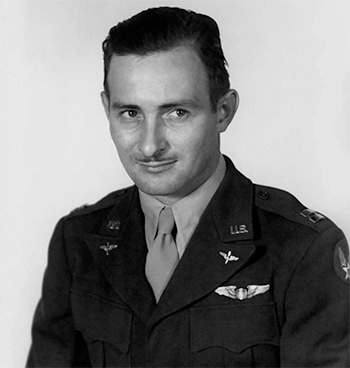
|
Arthur W. Gebaur, Jr. |
 |
|||
| Rank, Service | ||||
Lieutenant Colonel O-5, U.S. Air Force |
||||
| Veteran of: | ||||
|
||||
| Tribute: | ||||
Arthur Gebaur was born on February 22, 1919, in Kansas City, Missouri. He enlisted in the Aviation Cadet Program of the U.S. Army Air Forces for pilot training on December 12, 1941, and attended Primary Flight Training at the Visalia School of Aeronautics in Visalia, California, from December 1941 to February 1942. Gebaur next attended Basic Flight Training at Merced, California, from February to April 1942, followed by Advanced Flight Training at Luke Field, Arizona, from April 1942 until he was commissioned a 2nd Lieutenant and awarded his pilot wings there on June 23, 1942. Lt Gebaur attended Twin Engine Flight Instructor School at Mather Field, California, from June to August 1942, and then served as a B-25 Mitchell Flying Instructor with the Roswell Army Flying School at Roswell Army Air Field, New Mexico, from August 1942 to April 1943. His next assignment was as a B-25 Flying Instructor, Assistant Squadron Commander, Assistant Group Commander, and then Group Commander with the 311th Twin Engine Flying Training Group (redesignated the 3020th Army Air Forces Base Unit in May 1944) at La Junta Army Air Field, Colorado, from April 1943 to March 1945. Captain Gebaur attended B-26 Marauder transition training with the 2514th Army Air Forces Base Unit at Laughlin Field, Texas, from March to July 1945, and then with the war in Europe ended he was assigned as a B-25 flying instructor with he 3014th Army Air Forces Base Unit at Douglas Army Air Field, Arizona, from July to November 1945. His next assignment was as Assistant Commanding Officer of Squadron B with the 2518th Army Air Forces Base Unit at Enid Army Air Field, Oklahoma, from November 1945 to January 1946, and he left the United States for the Philippines in February 1946. Capt Gebaur was assigned as a Plans and Training Officer with the 29th Air Service Group at Clark Field in the Philippines in March 1946, and then served as a Group Personnel Officer with the 77th Air Service Group at Clark Field from April 1946 to April 1947. He then served as an Instructor Pilot with the 4th Airdrome Squadron at Clark Field from April to June 1947, returning to the United States the same month. Captain Gebaur served with the 400th, 401st, and 413th Army Air Forces Base Units at Hamilton Field, California, from July 1947 until he left active duty on October 14, 1947, having been promoted to Major in August 1947. Major Gebaur was recalled to active duty in the U.S. Air Force a few weeks later, on October 29, 1947, and then served with the 2621st Air Force Base Unit at Barksdale AFB, Louisiana, from December 1947 to September 1948. During this time he attended the Central Instructor School from December 1947 to February 1948, and then served as a multi-engine flying instructor. His next assignment was as a Flying Instructor, Flight Commander, Operations Officer, Tactical Officer, Senior Military Instructor, and then Squadron Commander with the 3575th Pilot Training Wing at Vance AFB, Oklahoma, from September 1948 to October 1951, and during this time he attended the Aircraft Gunnery School at Nellis AFB, Nevada, from July to September 1951. Major Gebaur served as an F-84 Thunderjet pilot with the 49th Fighter-Bomber Group at Taegu AB, South Korea, from October 1951 to January 1952, and then as an F-84 pilot and Executive Officer of the 7th Fighter-Bomber Squadron of the 49th Fighter-Bomber Group at Taegu AB from January to May 1952. His next assignment was as Squadron Commander and then Air Commander of the 7th Fighter-Bomber Squadron at Taegu AB from May 1952 until he was Killed in Action over North Korea on August 29, 1952, having been promoted to Lieutenant Colonel in July 1952. Lt Col Gebaur was officially listed as Missing in Action from August 29, 1952, until he was declared dead on December 31, 1953. He flew 99 combat missions during the Korean War. Although his remains have never been returned to the United States, he does have a cenotaph at Mount Washington Cemetery in Independence, Missouri. In April 1957, Grandview AFB, Missouri, was renamed Richards-Gebaur AFB in honor of two Kansas City, Missouri, aviators: 1st Lt John F. Richards, II (Killed in Action during World War I), and Lt Col Arthur W. Gebaur, Jr. |
||||
|
||||

